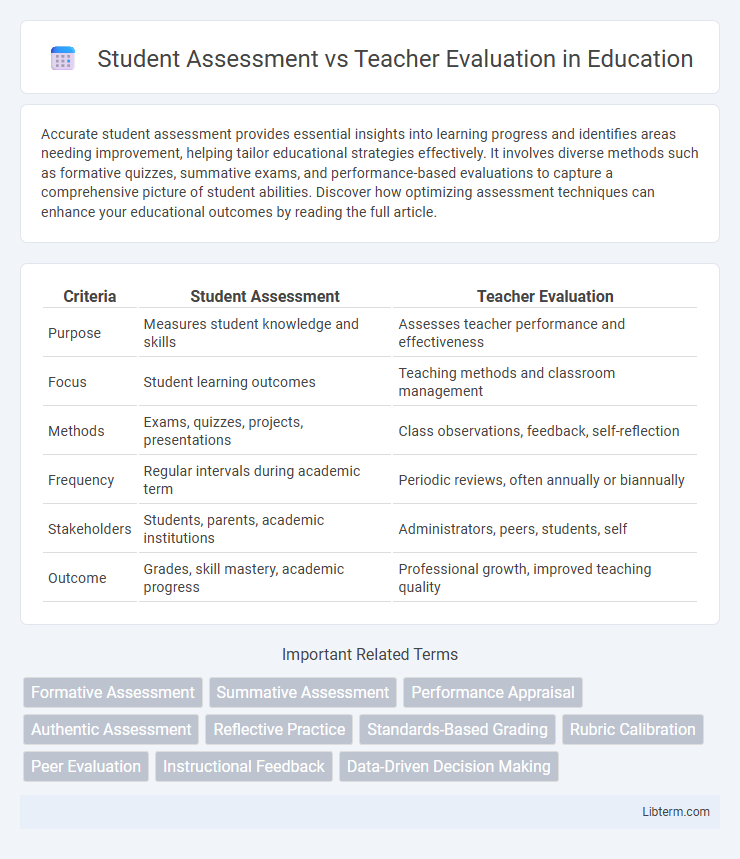Accurate student assessment provides essential insights into learning progress and identifies areas needing improvement, helping tailor educational strategies effectively. It involves diverse methods such as formative quizzes, summative exams, and performance-based evaluations to capture a comprehensive picture of student abilities. Discover how optimizing assessment techniques can enhance your educational outcomes by reading the full article.
Table of Comparison
| Criteria | Student Assessment | Teacher Evaluation |
|---|---|---|
| Purpose | Measures student knowledge and skills | Assesses teacher performance and effectiveness |
| Focus | Student learning outcomes | Teaching methods and classroom management |
| Methods | Exams, quizzes, projects, presentations | Class observations, feedback, self-reflection |
| Frequency | Regular intervals during academic term | Periodic reviews, often annually or biannually |
| Stakeholders | Students, parents, academic institutions | Administrators, peers, students, self |
| Outcome | Grades, skill mastery, academic progress | Professional growth, improved teaching quality |
Understanding Student Assessment: Key Concepts
Student assessment encompasses diverse methods such as formative, summative, diagnostic, and benchmark assessments designed to measure students' knowledge, skills, and progress. Key concepts include validity, reliability, and fairness, ensuring assessments accurately reflect student learning and provide actionable feedback. Understanding these principles enables educators to select appropriate tools that support personalized instruction and improve academic outcomes.
Teacher Evaluation: Purpose and Approaches
Teacher evaluation primarily aims to improve instructional quality and promote professional development by assessing teaching effectiveness through classroom observations, student performance data, and peer reviews. Approaches include formative evaluations for ongoing feedback and summative evaluations for performance appraisal, utilizing tools such as rubrics, self-assessments, and student surveys. Effective teacher evaluation systems align with educational standards and foster reflective practices to enhance student learning outcomes.
Differences Between Student Assessment and Teacher Evaluation
Student assessment measures learners' knowledge, skills, and competencies through tests, quizzes, and assignments to gauge academic performance. Teacher evaluation assesses educators' effectiveness, instructional methods, classroom management, and professional development based on observations, student feedback, and performance metrics. The primary difference lies in the focus: student assessment targets learning outcomes, whereas teacher evaluation concentrates on teaching quality and educator growth.
Objectives: Measuring Learning vs. Teaching Effectiveness
Student assessment targets measuring learning outcomes by evaluating knowledge retention, skill acquisition, and academic progress through tests, quizzes, and projects. Teacher evaluation focuses on teaching effectiveness by analyzing instructional methods, classroom management, and student engagement using observations, feedback, and performance metrics. Both processes aim to enhance educational quality but address different aspects: student assessment measures learner achievement, while teacher evaluation assesses the impact of teaching strategies.
Methods and Tools: Assessments vs. Evaluations
Student assessment methods often include standardized tests, quizzes, portfolios, and performance tasks designed to measure learning outcomes and skill mastery. Teacher evaluation tools commonly involve classroom observations, student feedback surveys, self-assessments, and professional development portfolios to gauge instructional effectiveness and teaching practices. Both processes utilize data-driven analytics and digital platforms to enhance accuracy, consistency, and actionable insights.
Impact on Educational Outcomes
Student assessment provides direct insight into learners' knowledge, skills, and progress, enabling tailored instructional strategies that improve educational outcomes. Teacher evaluation focuses on instructional effectiveness, professional development, and classroom management, influencing teaching quality and student engagement. Both processes are essential for enhancing academic achievement, but integrating student assessment data into teacher evaluation systems yields more targeted interventions and improved learning environments.
Challenges in Student Assessment
Student assessment faces challenges such as varying learning styles, subjective grading, and limited standardized metrics that can hinder accurate measurement of student capabilities. Inconsistent assessment tools and lack of comprehensive feedback reduce the effectiveness of evaluations in reflecting true student performance. These issues complicate efforts to tailor instruction and improve educational outcomes across diverse student populations.
Issues in Teacher Evaluation Practices
Teacher evaluation practices often face challenges related to subjectivity, lack of standardized criteria, and insufficient feedback mechanisms, which can undermine their effectiveness. Inconsistent evaluation methods lead to discrepancies in measuring teaching performance, affecting professional development opportunities and overall instructional quality. Addressing these issues requires implementing evidence-based frameworks that incorporate multiple data sources, including student assessment outcomes, peer reviews, and self-assessments.
Integrating Feedback for Continuous Improvement
Student assessment and teacher evaluation both serve as crucial feedback mechanisms that drive continuous improvement in education. Integrating formative assessments with teacher evaluations creates a comprehensive feedback loop, enabling targeted adjustments in teaching strategies and personalized student support. Leveraging data from standardized tests, classroom observations, and student self-assessments enhances the ongoing refinement of instructional practices and learning outcomes.
Future Trends in Assessment and Evaluation
Future trends in student assessment emphasize personalized learning analytics and AI-driven adaptive testing to provide real-time feedback tailored to individual student needs. Teacher evaluation is increasingly incorporating peer reviews and multi-source feedback systems to foster professional development and improve instructional quality. Both assessment and evaluation practices are moving towards integrating data-driven insights to support continuous improvement in education outcomes.
Student Assessment Infographic

 libterm.com
libterm.com